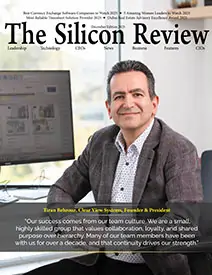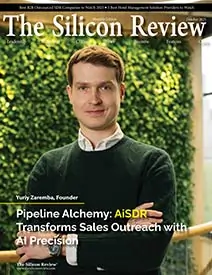50 Most Trustworthy Companies of the Year 2018
Single Source, Superior Build: Kaman Aerosystems
The Silicon Review
![]() We provide parts, components, systems, and programs that meet mission-critical aerospace and industrial challenges.
We provide parts, components, systems, and programs that meet mission-critical aerospace and industrial challenges.
Kaman Corporation is a diversified company that conducts business in two segments: Aerospace and Industrial Distribution. For more than 70 years, we have been recognized for technological breakthroughs and innovative solutions to critical challenges. Last year, Kaman Corporation generated more than $1.8 Billion in revenue from continuing operations and continues to grow both organically and through acquisitions. Further, Kaman conducts business around the globe and has customers in more than 50 countries.
From the initial flight of the K-125 to the first unmanned helicopter, Kaman has always broken new ground in aerospace technology. This timeline traces how a company started on a shoestring budget evolved into a worldwide leader in the aviation industry and one of the country’s largest distributors of industrial parts.
Over the past 70 years, Kaman has started, acquired and divested dozens of innovative businesses in fields ranging from aerospace and industrial distribution to music and scientific research.
The Odyssey of the Founder: Charles H. Kaman
"One of the first steps in any endeavor is overcoming the discouraging advice of those who say it can't be done."
Charles Huron Kaman was a 26-year-old engineer in 1945 when he founded Kaman Aircraft Company in the garage of his mother’s West Hartford, Connecticut home with $2,000 invested by two friends. He started the company to demonstrate a new rotor concept he devised to make helicopters stabler and easier to fly. Over the next half-century, Mr. Kaman built the company into a worldwide leader in the aviation industry. Kaman Aircraft, now Kaman Corporation, has become a billion-dollar company.
A pioneer in rotary-winged flight and one of Connecticut’s great inventors and innovators, Kaman achieved many breakthroughs, including the first gas turbine-powered helicopter, the first twin-turbine-powered helicopter, the first remotely controlled helicopter, and the first all-composite rotor blade. Over the years his helicopters set numerous records for performance and altitude.
While building a worldwide reputation as a successful inventor and entrepreneur, Mr. Kaman also became admired for his humanitarian efforts in connection with his work for the vision-impaired. With his late wife, Roberta, he founded Fidelco Guide Dog Foundation, a groundbreaking business, which breeds and trains guide dogs for the blind at its Bloomfield, CT headquarters.
Mr. Kaman was a leader who created a culture of accomplishment in his businesses, and who also created an environment where people knew they could be at their best in working for and with him. A visionary for his talents in diversifying the business, Mr. Kaman explored numerous other opportunities through Kaman Corporation, from laser optics and space systems to industrial services and distribution. In the 1960s, Mr. Kaman, an accomplished guitar player who once turned down an offer to play with Tommy Dorsey’s orchestra to pursue his career in helicopters, formed Kaman Music. He used his knowledge of vibration and composite materials gained from building helicopters to design the popular round-backed Ovation Guitar, a major innovation in the 20th-century music business.
Born on June 15, 1919, he grew up in Washington, D.C. His father, born in Germany, supervised construction on the Supreme Court and other buildings in the capital city. As a teen-aged aviation enthusiast, Charlie set national duration records for hand-launched model gliders. He dreamed of becoming a professional pilot, but deafness in one ear forced him to change his plans.
He earned a bachelors degree in aeronautical engineering from Catholic University, graduating magna cum laude in 1940. He took a position in the propeller performance unit at Hamilton Standard. While working on propeller dynamics, he met Igor Sikorsky, who was developing helicopters for another division of United Aircraft. As he later recalled, his life was changed the first time he observed Mr. Sikorsky’s pioneering work with helicopters.
When Mr. Kaman entered the fledgling business of vertical flight, helicopters were unstable and difficult to fly. While working at home nights and weekends, Mr. Kaman developed a new concept of rotor control based on “servo-flaps.” These were small ailerons added to the edges of the rotor blades to improve helicopter stability. He also proposed intermeshing rotors, which would increase lift while eliminating the tail rotor. These inventions became the hallmarks of all Kaman helicopters to follow.
The first Kaman helicopter, the K-125, lifted off the ground on January 15, 1947. It was a short flight, with the aircraft tethered to remain within six inches of the ground. The first free flight occurred that spring, with a test pilot executing a vertical takeoff to 50 feet and flying figure-eights at 50-60 miles per hour.
The company got its first big break in 1948 when the U.S. Navy bought two of his helicopters for evaluation. Kaman’s SH-2 Seasprite line of helicopters flew more than one million hours in service with the U.S. Navy in anti-submarine warfare, anti-ship surveillance and targeting, search and rescue, and utility operations.
One of the proudest accomplishments of Mr. Kaman’s distinguished career was the more than 15,000 lives that Kaman helicopters were estimated to have saved over the second half of the 20th century. The Kaman H-43 “Huskie” flew more rescue missions during the Korean and Vietnam wars than all other helicopters combined, and remains the only military helicopter to serve throughout its service life with no loss of life or accidents attributed to its design.
In 1992, Kaman introduced the K-MAX "aerial truck," the first helicopter specifically designed for repetitive heavy-lift operations. K-MAX has been used in logging, construction, mining, firefighting, oil and gas exploration, and other high-altitude work. In keeping with the value Mr. Kaman always put on human life, two K-MAX aircraft are currently undergoing modifications to be deployed to Afghanistan in an unmanned cargo resupply role.
While Kaman Corporation stands as a testament to his significant business achievements, a series of distinguished awards speak to Mr. Kaman’s human achievements. In 1997, he joined other aviation greats including Charles Lindbergh, Jimmy Doolittle, Neil Armstrong and Igor Sikorsky as a recipient of the National Aeronautic Association's Wright Brothers Memorial Trophy, the nation's premier aviation award.
President Clinton presented him with the National Medal of Technology, the nation's highest recognition for contributions to the technical excellence, in 1996. He also received the Connecticut Medal of Technology; the U.S. Department of Defense Distinguished Public Service Medal; the Aviation Week and Space Technology Laurel; and the Fleet Admiral Chester W. Nimitz Award.
He was inducted into the Hall of Honor of the National Museum of Naval Aviation and was named an Honorary Fellow of the Royal Aeronautical Society. He also received honorary doctorates from the University of Connecticut, the University of Hartford, of which he was one of a group of founders, and the University of Colorado. At the time of his death, Mr. Kaman was chairman emeritus of the corporation.
One of the leading aviation pioneers of the 20th century and a great entrepreneur and humanitarian, Mr. Kaman died on Monday, January 31, 2011, in Bloomfield, CT. He was 91.
Solutions Portfolio
Engineering Services: We offer engineering design and analysis solutions that help our customers maintain and develop core engineering competencies in-house through our knowledge transfer model while addressing cost, quality, skills and confidentiality concerns.
Engineering design and analysis solutions customized for each customer's requirements. We provide our global customer base with a broad array of aerospace engineering design and analysis solutions that address cost, quality, skills, and confidentiality.
Tooling: Kaman Tooling’s design and engineering team use the latest CATIA and CAD software, training manuals and on-site tooling training, concurrent and reverse engineering. Our team includes fully trained and accredited project and program managers.
We provide a full engineering service comprised of a large multi-disciplined conventional tool room, supported by a CMM machine and a large 3 & 5 axis cnc machining center capable of machining small tertiary parts up to 6m in length.
Kaman Tooling has an AS9100 Rev. C quality management system, along with numerous customer accreditations, including BAE Systems, Rolls Royce, Agusta Westland, Spirit, and Bombardier. We have received ISO 14001 environmental management accreditation and ISO 18001 health and safety management accreditation.
Composite Structures: Design and build of structural composite assemblies for flight critical applications. Kaman produces a range of composite structures, producing monolithic and sandwich parts from a range of materials, including carbon fiber composite, glass, and Aramid cured by autoclave.
Integrated Structures and Metallics: Providing total aerostructures solutions for the domestic and international aerospace markets.
The world’s major aerospace primes repeatedly turn to Kaman Integrated Structures & Metallics to meet their critical requirements on aggressive delivery schedules and complex statements of work.
They know when they turn to Kaman Integrated Structures & Metallics that they will receive the capabilities and experience of not just a Tier II supplier, but also a Super Tier II Structures Supplier that can serve as a Tier I on certain programs.
Testing: Kaman has an extensive history of static and fatigue testing of aircraft components up to full-size airframes. In addition to airframe testing, Kaman has extensive experience in aircraft component and coupon testing. Tests have included main rotor blades, hub, flight controls and any aircraft part that requires U.S. government or FAA certification or requalification. Listed below are recent full-scale tests.
With diverse manufacturing capabilities and highly experienced people, Kaman Air Vehicles & MRO is well qualified to design, test, certify and develop complete air vehicles, major assemblies, complex components, subassemblies, and detail parts.
Knowing the Key Executive
Neal j. Keating, Chairman, President, and Chief Executive Officer:
![]() Neal J. Keating is Chairman, President, and Chief Executive Officer, as well as a member of the Board of Directors, having joined the Company in September 2007. In this role, Neal provides leadership for the combined businesses which serve U.S. industrial markets, as well as the global defense and commercial aerospace markets.
Neal J. Keating is Chairman, President, and Chief Executive Officer, as well as a member of the Board of Directors, having joined the Company in September 2007. In this role, Neal provides leadership for the combined businesses which serve U.S. industrial markets, as well as the global defense and commercial aerospace markets.
Prior to Kaman, Mr. Keating has served as Chief Operating Officer at Hughes Supply, a $5.4 billion industrial distributor, as Chief Executive Officer of GKN Aerospace, a $1 billion aerospace subsidiary of GKN, Plc, serving also as Executive Director on the Board of Directors of GKN Plc and as a member of the Board of Directors of Agusta-Westland Helicopter. From 1978 to 2002, he served in increasingly senior positions at Rockwell International with his final assignment being Executive Vice President and Chief Operating Officer of Rockwell Collins, Commercial Systems.
Mr. Keating also serves on the Board of Directors of Hubbell, Inc., as Chairman of the MAPI Board of Trustees, on the Board of Governors of the Aerospace Industry Association (AIA), and as a member of the Board of Directors of Avon Old Farms School.
Mr. Keating holds a BS in Electrical Engineering from the University of Illinois and earned his MBA from The University of Chicago. Neal and his family reside in Farmington, CT. He also actively competes in triathlons and marathons and is a three-time finisher of the Boston Marathon. Since 2001 he has used his participation in these events to raise money in support of the families of our fallen hero's through Injured Marine Semper Fi Fund, the Marine Corp/Law Enforcement Foundation, and the Navy SEAL Foundation.
“Our people have always sought a better way, from helping clients operate more efficiently to pioneering safer ways to fly. We have grown on the strength of the innovation of our people.”
_2025-12-15_12-44-58.webp)


_2025-11-17_06-38-14.webp)

 (1)_2025-10-21_13-35-14.webp)
